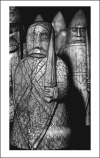 |
Scottish Annotated Games |
Last updated 11 July 2001


|
Pyrich, G D - Nightingale, D [A20]
Reg Gillman Memorial, 1999
[Notes by George Pyrich]
In some games the variations which which aren't played are more interesting
than those which are. The following is one such game. 1.c4 e5 2.g3
The move order favoured by Kosten in his "The Dynamic English"
2...c6
3.d4 Now we have a reversed Sicilian 2.c3 where White has the extra move
2.g3 I've long held the view that 2...Nf6 is Black's best against 2.c3 so
maybe I should have played 3.Nf3 here
3...exd4 [3...Bb4+ 4.Bd2 Bxd2+
5.Qxd2 d6 leads to an entirely different set-up]
4.Qxd4 d5 5.cxd5 cxd5
6.Bg2 Be6 Kosten gives only 6.... Nf6
7.Nf3 Nc6 8.Qa4 Bc5 [I'd
expected 8...Nf6 when 9.Nc3 looks better for White, for example 9...Qb6
10.0-0 Bc5 11.Qc2 Nb4 12.Qa4+ Bd7 13.Qb3 0-0 14.a3 Nc6 15.Qxb6 Bxb6 16.Bg5]
9.0-0 Now we have a position similar to that in Tarrasch Defence
where Black's easy development and active pieces compensate for the
supposedly weak pawn at d5
9...h6 Another surprise. [Maybe he
could have saved a move with 9...Nge7 when 10.Nc3 0-0 11.Bf4 a6 (11...Ng6
12.Rad1 Nxf4 13.Qxf4 Rc8 14.a3 also looks o.k. for Black) 12.Rad1
is roughly equal]
10.Nc3 Nge7 Again unexpected! After his previous I
thought he was playing [10...Nf6 when of course I can't play 11.Bg5
Instead 11.Bf4 0-0 12.Rac1 (Maybe 12.Rad1 ) 12...Rc8 13.a3 is
again about equal although White has always to consider the agressive pawn
advance g5!?]
11.Bf4 [Instead 11.Ne5 looks to only help Black e.g.
11...0-0 12.Nxc6 bxc6 13.Bf4 Ng6 14.Rad1 Qb6]
11...a6 [If 11...Ng6
then 12.Rad1 looks good for White (12.Nb5?! can't be good)
12...0-0 (12...Nxf4 13.gxf4 0-0 14.f5! is excellent for
White) 13.Nxd5 Bxd5 14.e4 Nxf4 15.gxf4 Bb3 16.Qxb3 Qe7 17.Rd5]
12.Rad1 0-0 [12...g5?! 13.Be5 b5 14.Qb3 Nxe5 15.Nxe5 must be good
for White]
13.a3 [13.Ne4!? seems to only invite complications
13...Ba7! (13...dxe4? 14.Rxd8 Raxd8 15.Qxe4 Bxa2) ; Instead 13.Rd2
b5 14.Qd1 Qa5 (14...b4 15.Ne4 dxe4 16.Rxd8 Raxd8 17.Nd2 f5) 15.Ne5
Nxe5 16.Bxe5 Rac8 looks comfortable for Black; whilst 13.Nxd5?? walks into
13...Nxd5 14.e4 Nb6]
13...Rc8 [if 13...Ng6 then 14.e3 (maybe
14.e4!? ) 14...Re8 15.Rd2 (15.Ne1 looks playable too
15...Nxf4 16.Qxf4 Ne7 17.Qe5 Bd6 18.Qh5) 15...b5 16.Qd1 (16.Qc2
Bb6 should be o.k. for Black) 16...Nxf4 17.gxf4 b4 18.Nxd5 bxa3
19.Qc2 with 20.f5 to follow looks fine for White]
14.Ne5 I was
reluctant to play this but the alternatives didn't look too good
[14.Rd2? g5! 15.Be3 (15.Be5 g4) 15...Bxe3 16.fxe3 Nf5 17.e4 Qb6+;
14.e4 d4 looks a bit messy; However 14.b4 looks better with hindsight
14...Bb6 15.Ne4 Ng6 16.Nc5 Nxf4 17.gxf4 Qe7 18.Rc1 (18.f5!?)
18...Bxc5 19.Rxc5 d4 offers chances for both sides; but 14.Ne1 looks
very unclear after 14...g5!? (14...Re8 is more restrained!)
15.Nd3 Ba7 16.Bd2 f5]
14...d4 [Now 14...g5? is clearly bad after
15.Nxc6 Rxc6 16.Be5 b5 17.Qb3 d4 18.Qc2 Bf5 19.Qd2; but 14...Re8 was what
I'd expected. After 15.Nxc6 Rxc6 16.Rd2 Qc8 17.Nxd5 Nxd5 18.Bxd5 Bxd5
19.Rxd5 Rxe2 20.Qd1 it's about equal; whilst 14...Nxe5 15.Bxe5 Re8 16.Bd4 is
fine for White who would like to exchange the black-squared B's and then
attack the d5 pawn]
15.Nd3 [15.Nxc6 Nxc6 16.Ne4 Be7 only helps
Black; as does 15.e3 Qb6 16.exd4 Bxd4 17.Nxc6 Nxc6]
15...Ba7 16.Ne4 Nd5
[16...Ng6 allows 17.Bd6 when one nice line is 17...Re8 18.Bc5 Bf5!?
19.Nd6 Bxc5 20.Nxb7 Qb6 21.Nbxc5 Rxe2 22.Rfe1 Rxe1+ 23.Rxe1 a5 24.Be4 Bxe4
25.Rxe4 and it's about equal]
17.Rc1 probably best as [17.Bd2
leaves the Q short of squares after 17...Nb6! 18.Qc2 Nb4 19.Qb1 Nxd3 20.exd3
f5; and 17.Bd6 also looks bad 17...Re8 18.Bc5 b6 19.Bb4 Bb8! 20.Qxa6 Ndxb4
21.axb4 Bd5 with strong compensation for the pawn; but 17.Nd6 is unclear
after 17...Nxf4 18.Nxc8 Nxe2+ 19.Kh1 Qxc8 20.Rfe1 Bg4 21.f3 Nxg3+ 22.hxg3
Bf5 with 2 pawns for the exchange and attacking chances with the 2 B's
against the weakened White K]
17...Bg4 [Now 17...Nb6 18.Qc2 Nb4
19.Qd2 is o.k. for White; as is 17...Nxf4 18.Nxf4 Qe7 19.b4; but 17...Re8 is
interesting 18.Nec5 Bxc5 (18...Nxf4 19.Nxf4 Bxc5 20.Rxc5 Bd7 21.Qc2 Bg4
22.Re1 Qd6 23.b4 is probably good for White) 19.Rxc5 with equal
chances]
18.Rfe1 [18.Nec5? allows 18...Bxe2 19.Nxb7 Qd7 20.Ndc5 Bxc5
21.Nxc5 Qf5]
18...Nxf4 19.Nxf4 Qe7 protecting c5 Instead
[19...Re8 20.h3 Be6 21.Nc5 Bxc5 22.Rxc5]
20.b4 [20.Nd5 was a better
try 20...Qe5 21.e3 Rfd8? (21...Bd7! 22.exd4 Nxd4 23.Qd1 Rxc1 24.Qxc1 Kh8
25.Nec3 Qf5 26.Qf4 Bc6 27.Qxf5 Nxf5 28.Re5 Nd6 29.Re7) 22.exd4 Qxd4
23.Rc4 Qd3 24.Nef6+ is winning for White!]
20...Rfd8 [20...Rfe8 was
tricky as White has to mind his back rank e.g. 21.Nc5 Bxc5 22.Rxc5 Ne5
23.Rec1 Rxc5 24.Rxc5?? d3! 25.Rc7 (25.exd3 Nf3+ 26.Bxf3 Qe1+ 27.Kg2 Qh1+
28.Kxh1 Bxf3+ 29.Ng2 Re1# is a nice mate) 25...dxe2-+]
21.Nd3
seems best as [21.Nc5 is still risky 21...Bxc5 22.Rxc5? d3
23.Bxc6 d2 24.Rd1 Rxc6]
21...Ne5 22.Nec5 Better than
[22.Nxe5 Rxc1 23.Rxc1 Qxe5]
22...Bxc5 [I was unsure about 22...b6
when 23.Nxe5 Qxe5 24.Nd3 Rxc1 25.Rxc1 Qxe2 26.Qxa6 is unclear! The a7 B is
"stuck" but the d4 might become a monster! 26...Bf5 (26...Bf3?? 27.Re1)
27.Qxa7 Qxd3 28.Qxb6 Re8]
23.bxc5 [Again 23.Nxc5 allows 23...b6
24.Nb7 Rxc1 25.Rxc1 Rd7 26.Qxa6 d3 27.exd3 Nf3+ 28.Bxf3 Bxf3 and it's all
over!]
23...Nxd3 Now things just fizzle out
24.exd3 Rxc5 25.Qb4
Re8 26.Bxb7 [26.Rb1? Rb5!]
26...Rxc1 [if 26...Bh3 simply
27.Ra1 gives Black nothing]
27.Rxc1 Qf6 [27...a5 comes to nothing
after 28.Qa4 Bf5 29.Bd5 Bxd3 30.Qxd4 Bb5 (30...Qxa3?? 31.Ra1
wins!) ]
28.Re1 With a draw offer which was
accepted [Instead 28.Be4?? Rxe4! 29.dxe4 Qf3 30.Qb8+ Kh7 31.Qf4 Qxf4
32.gxf4 d3 would have been a sad end!] ½-½
| Click to return to index page Games Index |
Click to download in PGN format Pyrich v Nightingale |
Generated with ChessBase 7.0 |





















